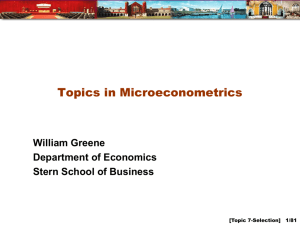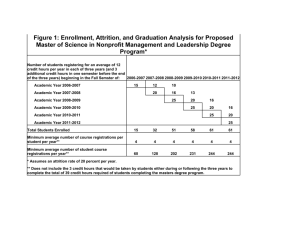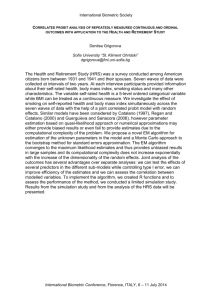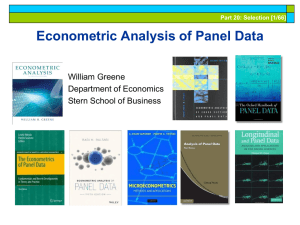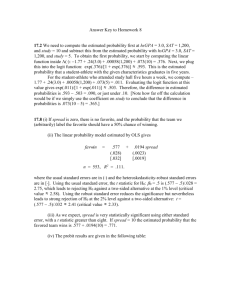Sample Selection in Nonlinear Models
advertisement
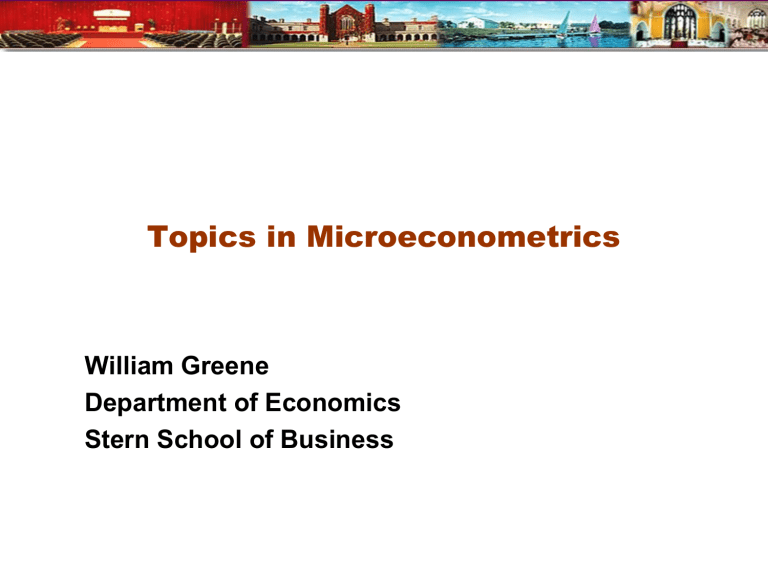
Topics in Microeconometrics William Greene Department of Economics Stern School of Business Part 5: Sample Selection in Nonlinear and Panel Models Samples and Populations • Consistent estimation • • • • • The sample is randomly drawn from the population Sample statistics converge to their population counterparts A presumption: The ‘population’ is the population of interest. Implication: If the sample is randomly drawn from a specific subpopulation, statistics converge to the characteristics of that subpopulation. These may not be the same as the full population Can one generalize from the subpopulation to the full population? Nonrandom Sampling • • • • Simple nonrandom samples: Average incomes of airport travelers mean income in the population as a whole? Survivorship: Time series of returns on business performance. Mutual fund performance. (Past performance is no guarantee of future success. ) Attrition: Drug trials. Effect of erythropoetin on quality of life survey. Self-selection: • • Labor supply models Shere Hite’s (1976) “The Hite Report” ‘survey’ of sexual habits of Americans. “While her books are ground-breaking and important, they are based on flawed statistical methods and one must view their results with skepticism.” Heckman’s Canonical Model A behavioral model: Offered wage = o* = β'x + v (x age,experience,educ...) Reservation wage = r* = δ'z + u (z = age, kids, family stuff) Labor force participation: LFP = 1 if o* r*, 0 otherwise Prob(LFP=1) = (β'x -δ'z )/ 2v u2 Desired Hours = H* = 'w + Actual Hours = H* if LFP = 1 unobserved if LFP = 0 and u are correlated. and v might be correlated. What is E[H* | w ,LFP = 1]? Not 'w. Dueling Selection Biases – From two emails, same day. • • “I am trying to find methods which can deal with data that is non-randomised and suffers from selection bias.” “I explain the probability of answering questions using, among other independent variables, a variable which measures knowledge breadth. Knowledge breadth can be constructed only for those individuals that fill in a skill description in the company intranet. This is where the selection bias comes from.” Sample Selection Observations • The selection ‘problem’ is caused by the correlation of the unobservables • • • • Selection on observables is often manageable within the conventional model. Selection on unobservables often requires a more detailed specification of the model – where does the effect come from? The ‘bias’ relates to the inconsistency of familiar estimators such as least squares The data are not biased; the (an) estimator is biased. Standard Sample Selection Model di * ' zi ui di = 1(di * > 0) y i * = ' x i +i yi = y i * when di = 1, unobserved otherwise (ui ,v i ) ~ Bivariate Normal[(0,0),(1,,2 )] E[y i | y i is observed] = E[y i|di=1] = ' x i+E[ i | di 1] = ' x i+E[ i | ui ' z i ] = ' x i+( ) = ' x i+ i ( ' zi ) ( ' z i ) Incidental Truncation u1,u2~N[(0,0),(1,.71,1) Unconditional distribution of u2 ~ N[0,1] Conditional distribution of u2|u1 > 0. No longer ~ N[0,1] Selection as a Specification Error • • E[yi|xi,yi observed] = β’xi + θ λi Regression of yi on xi omits λi. • • • • λi will generally be correlated with xi if zi is. zi and xi often have variables in common. There is no specification error if θ = 0 ρ = 0 The “selection bias” is plim (b – β) Estimation of the Selection Model • Two step least squares • • • • Inefficient Simple – exists in current software Simple to understand and widely used Full information maximum likelihood • • • Efficient. Not more or less robust Simple to do – exists in current software Not so simple to understand – widely misunderstood Estimation Heckman’s two step procedure • • (1) Estimate the probit model and compute λi for each observation using the estimated parameters. (2) a. Linearly regress yi on xi and λi using the observed data b. Correct the estimated asymptotic covariance matrix for the use of the estimated λi. (An application of Murphy and Topel (1984) – Heckman was 1979). Mroz Application – Labor Supply MROZ labor supply data. Cross section, 753 observations Use LFP for binary choice, KIDS for count models. LFP = labor force participation, 0 if no, 1 if yes. WHRS = wife's hours worked. 0 if LFP=0 KL6 = number of kids less than 6 K618 = kids 6 to 18 WA = wife's age WE = wife's education WW = wife's wage, 0 if LFP=0. RPWG = Wife's reported wage at the time of the interview HHRS = husband's hours HA = husband's age HE = husband's education HW = husband's wage FAMINC = family income MTR = marginal tax rate WMED = wife's mother's education WFED = wife's father's education UN = unemployment rate in county of residence CIT = dummy for urban residence AX = actual years of wife's previous labor market experience AGE = Age AGESQ = Age squared EARNINGS= WW * WHRS LOGE = Log of EARNINGS KIDS = 1 if kids < 18 in the home. Labor Supply Model NAMELIST ; Z = One,KL6,K618,WA,WE,HA,HE $ NAMELIST ; X = One,KL6,K618,Age,Agesq,WE,Faminc $ PROBIT ; Lhs = LFP ; Rhs = Z ; Hold(IMR=Lambda) $ SELECT ; Lhs = WHRS ; Rhs = X $ REGRESS ; Lhs = WHRS ; Rhs = X,Lambda $ REJECT ; LFP = 0 $ REGRESS ; Lhs = WHRS ; Rhs = X $ Participation Equation +---------------------------------------------+ | Binomial Probit Model | | Dependent variable LFP | | Weighting variable None | | Number of observations 753 | +---------------------------------------------+ +---------+--------------+----------------+--------+---------+----------+ |Variable | Coefficient | Standard Error |b/St.Er.|P[|Z|>z] | Mean of X| +---------+--------------+----------------+--------+---------+----------+ Index function for probability Constant 1.00264501 .49994379 2.006 .0449 KL6 -.90399802 .11434394 -7.906 .0000 .23771580 K618 -.05452607 .04021041 -1.356 .1751 1.35325365 WA -.02602427 .01332588 -1.953 .0508 42.5378486 WE .16038929 .02773622 5.783 .0000 12.2868526 HA -.01642514 .01329110 -1.236 .2165 45.1208499 HE -.05191039 .02040378 -2.544 .0110 12.4913679 Hours Equation +----------------------------------------------------+ | Sample Selection Model | | Two stage least squares regression | | LHS=WHRS Mean = 1302.930 | | Standard deviation = 776.2744 | | WTS=none Number of observs. = 428 | | Model size Parameters = 8 | | Degrees of freedom = 420 | | Residuals Sum of squares = .2267214E+09 | | Standard error of e = 734.7195 | | Correlation of disturbance in regression | | and Selection Criterion (Rho)........... -.84541 | +----------------------------------------------------+ +---------+--------------+----------------+--------+---------+----------+ |Variable | Coefficient | Standard Error |b/St.Er.|P[|Z|>z] | Mean of X| +---------+--------------+----------------+--------+---------+----------+ Constant 2442.26665 1202.11143 2.032 .0422 KL6 115.109657 282.008565 .408 .6831 .14018692 K618 -101.720762 38.2833942 -2.657 .0079 1.35046729 AGE 14.6359451 53.1916591 .275 .7832 41.9719626 AGESQ -.10078602 .61856252 -.163 .8706 1821.12150 WE -102.203059 39.4096323 -2.593 .0095 12.6588785 FAMINC .01379467 .00345041 3.998 .0001 24130.4229 LAMBDA -793.857053 494.541008 -1.605 .1084 .61466207 Selection “Bias” of OLS +---------+--------------+----------------+--------+---------+----------+ |Variable | Coefficient | Standard Error |b/St.Er.|P[|Z|>z] | Mean of X| +---------+--------------+----------------+--------+---------+----------+ Constant 2442.26665 1202.11143 2.032 .0422 KL6 115.109657 282.008565 .408 .6831 .14018692 K618 -101.720762 38.2833942 -2.657 .0079 1.35046729 AGE 14.6359451 53.1916591 .275 .7832 41.9719626 AGESQ -.10078602 .61856252 -.163 .8706 1821.12150 WE -102.203059 39.4096323 -2.593 .0095 12.6588785 FAMINC .01379467 .00345041 3.998 .0001 24130.4229 LAMBDA -793.857053 494.541008 -1.605 .1084 .61466207 +---------+--------------+----------------+--------+---------+----------+ |Variable | Coefficient | Standard Error |t-ratio |P[|T|>t] | Mean of X| +---------+--------------+----------------+--------+---------+----------+ Constant 1812.12538 1144.33342 1.584 .1140 KL6 -299.128041 100.033124 -2.990 .0030 .14018692 K618 -126.399697 30.8728451 -4.094 .0001 1.35046729 AGE 11.2795338 53.8442084 .209 .8342 41.9719626 AGESQ -.26103541 .62632815 -.417 .6771 1821.12150 WE -47.3271780 17.2968137 -2.736 .0065 12.6588785 FAMINC .01261889 .00338906 3.723 .0002 24130.4229 Maximum Likelihood Estimation logL + d1 d=0 exp 12 (i / )2 ( / ) ' z i i log 2 2 1 log 1 ( ' zi ) Re parameterize this: let qi ' zi (1) = 1/ (2) = / (Olsen transformation) (3) = / 1-2 (4) Constrain to be in (-1,1) by using = 1 2 logL ln 1 1 d0 a tanh , so =atanh-1 () log( qi ) d1 exp(2) 1 exp(2) 1 log 12 log 2 12 (y i ' x i )2 log [(y i ' x i ) qi 1 2 ] +---------------------------------------------+ | ML Estimates of Selection Model | | Maximum Likelihood Estimates | | Number of observations 753 | | Iterations completed 47 | | Log likelihood function -3894.471 | | Number of parameters 16 | | FIRST 7 estimates are probit equation. | +---------------------------------------------+ +---------+--------------+----------------+--------+---------+ |Variable | Coefficient | Standard Error |b/St.Er.|P[|Z|>z] | +---------+--------------+----------------+--------+---------+ Selection (probit) equation for LFP Constant 1.01350651 .54823177 1.849 .0645 KL6 -.90129694 .11081111 -8.134 .0000 K618 -.05292375 .04137216 -1.279 .2008 WA -.02491779 .01428642 -1.744 .0811 WE .16396194 .02911763 5.631 .0000 HA -.01763340 .01431873 -1.231 .2181 HE -.05596671 .02133647 -2.623 .0087 Corrected regression, Regime 1 Constant 1946.84517 1167.56008 1.667 .0954 KL6 -209.024866 222.027462 -.941 .3465 K618 -120.969192 35.4425577 -3.413 .0006 AGE 12.0375636 51.9850307 .232 .8169 AGESQ -.22652298 .59912775 -.378 .7054 WE -59.2166488 33.3802882 -1.774 .0761 FAMINC .01289491 .00332219 3.881 .0001 SIGMA(1) 748.131644 59.7508375 12.521 .0000 RHO(1,2) -.22965163 .50082203 -.459 .6466 MLE MLE vs. Two Step Two Step Constant 2442.26665 1202.11143 2.032 KL6 115.109657 282.008565 .408 K618 -101.720762 38.2833942 -2.657 AGE 14.6359451 53.1916591 .275 AGESQ -.10078602 .61856252 -.163 WE -102.203059 39.4096323 -2.593 FAMINC .01379467 .00345041 3.998 LAMBDA -793.857053 494.541008 -1.605 | Standard error of e = 734.7195 | Correlation of disturbance in regression | and Selection Criterion (Rho)........... -.84541 MLE Constant 1946.84517 1167.56008 1.667 KL6 -209.024866 222.027462 -.941 K618 -120.969192 35.4425577 -3.413 AGE 12.0375636 51.9850307 .232 AGESQ -.22652298 .59912775 -.378 WE -59.2166488 33.3802882 -1.774 FAMINC .01289491 .00332219 3.881 SIGMA(1) 748.131644 59.7508375 12.521 RHO(1,2) -.22965163 .50082203 -.459 .0422 .6831 .0079 .7832 .8706 .0095 .0001 .1084 | | | .0954 .3465 .0006 .8169 .7054 .0761 .0001 .0000 .6466 .14018692 1.35046729 41.9719626 1821.12150 12.6588785 24130.4229 .61466207 Extension – Treatment Effect What is the value of an elite college education? di *=zi γ+ui ; di =1[di * > 0] (probit) y i *=x iβ+di i observed for everyone [i ,ui ]~Bivariate Normal[0,0,2 , ,1] E[y i *|x i ,di=1] = x iβ + + E[i | x i , di 1] = x iβ + + E[i | x i ,ui zi γ ] (zi γ ) = x iβ + ( z γ ) i = x iβ + +i E[y i *|x i ,di=0] = x iβ + E[i | x i , di 0] (zi γ ) = x iβ ( z γ ) i Least squares is still biased and inconsistent. Left out variable Treatment Effect E[y i *|x i ,di =1] - E[y i *|x i ,di=0] (zi γ) = x iβ + + ( z γ ) i (zi γ) - x iβ - (zi γ) (zi γ) (zi γ) (zi γ) (zi γ) Treatment + Selection Effect Sample Selection in Exponential Regression An approach modeled on Heckman's model Regression Equation: Prob[y=j|x,u]=P(λ); λ=exp(x β+θu) Selection Equation: d=1[zδ+ε>0] (The usual probit) [u,ε]~n[0,0,1,1,ρ] (Var[u] is absorbed in θ) Estimation: Nonlinear Least Squares: [Terza (1998).] 2 Φ(zδ+ρ) E[y|x,d=1]=exp(x β+θρ ) Φ(zδ) Panel Data and Selection Selection equation with time invariant individual effect dit 1[zit γ i it 0] Observation mechanism: (y it , x it ) observed when dit 1 Primary equation of interest Common effects linear regression model y it | (dit 1) x it β i it " Selectivity " as usual arises as a problem when the unobservables are correlated; Corr(it , it ) 0. The common effects, i and i make matters worse. Panel Data and Sample Selection Models: A Nonlinear Time Series I. 1990-1992: Fixed and Random Effects Extensions II. 1995 and 2005: Model Identification through Conditional Mean Assumptions III. 1997-2005: Semiparametric Approaches based on Differences and Kernel Weights IV. 2007: Return to Conventional Estimators, with Bias Corrections Panel Data Sample Selection Models Verbeek, Economics Letters, 1990. dit 1[zit γ w i it 0] (Random effects probit) y it | (dit 1) x it β i it ; (Fixed effects regression) Proposed "marginal likelihood" based on joint normality zit γ + it ui,1 ditui,2 f(ui,1 ,ui,2 )dui,1dui,2 logL i t 1 (2dit 1) 2 2 (1 dit ) it ( / )dit (y it y i ) ( x it x i )'β (Integrate out the random effects; difference out the fixed effects.) Ti ui,1 ,ui,2 are time invariant uncorrelated standard normal variables How to do the integration? Natural candidate for simulation. (Not mentioned in the paper. Too early.) [Verbeek and Nijman: Selectivity "test" based on this model, International Economic Review, 1992.] Zabel – Economics Letters • • • Inappropriate to have a mix of FE and RE models Two part solution • Treat both effects as “fixed” • Project both effects onto the group means of the variables in the equations (Mundlak approach) • Resulting model is two random effects equations Use both random effects Selection with Fixed Effects yit * i xit it , i xi wi , wi ~ N [0,1] dit * i zit uit , i zi vi , vi ~ N [0,1] (it , uit ) ~ N 2 [(0, 0), ( 2 ,1, )]. Li dit 0 zit zi vi (vi ) dvi z z v ( / ) i i it it 2 1 d 1 dvi dwi - it 1 it ( v , w ) 2 i i it yit xit xi wi Practical Complications The bivariate normal integration is actually the product of two univariate normals, because in the specification above, vi and wi are assumed to be uncorrelated. Vella notes, however, “… given the computational demands of estimating by maximum likelihood induced by the requirement to evaluate multiple integrals, we consider the applicability of available simple, or two step procedures.” Simulation The first line in the log likelihood is of the form Ev[d=0(…)] and the second line is of the form Ew[Ev[(…)(…)/]]. Using simulation instead, the simulated likelihood is LSi 1 R R r 1 dit 0 zit zi vi ,r zit zi vi ,r ( / )it ,r 1 it ,r dit 1 2 1 yit xit xi wi ,r 1 R R r 1 it ,r Correlated Effects Suppose that wi and vi are bivariate standard normal with correlation vw. We can project wi on vi and write wi = vwvi + (1-vw2)1/2hi where hi has a standard normal distribution. To allow the correlation, we now simply substitute this expression for wi in the simulated (or original) log likelihood, and add vw to the list of parameters to be estimated. The simulation is then over still independent normal variates, vi and hi. Conditional Means A Feasible Estimator Estimation Kyriazidou - Semiparametrics Assume 2 periods Estimate selection equation by FE logit Use first differences and weighted least squares: 1 ˆ i xi yi ˆ = Ni=1di1di2 i x i xi Ni=1di1di2 1 w iˆ ˆ i K kernel function. h h Use with longer panels - any pairwise differences Extensions based on pairwise differences by RochinaBarrachina and Dustman/Rochina-Barrachina (1999) Bias Corrections • • Val and Vella, 2007 (Working paper) Assume fixed effects • • Bias corrected probit estimator at the first step Use fixed probit model to set up second step Heckman style regression treatment. Postscript • What selection process is at work? • • • • • All of the work examined here (and in the literature) assumes the selection operates anew in each period An alternative scenario: Selection into the panel, once, at baseline. Alternative: Sequential selection = endogenous attrition (Wooldridge 2002, inverse probability weighting) Why aren’t the time invariant components correlated? Other models • • All of the work on panel data selection assumes the main equation is a linear model. Any others? Discrete choice? Counts? Attrition • • In a panel, t=1,…,T individual I leaves the sample at time Ki and does not return. If the determinants of attrition (especially the unobservables) are correlated with the variables in the equation of interest, then the now familiar problem of sample selection arises. Dealing with Attrition in a QOL Study • • The attrition issue: Appearance for the second interview was low for people with initial low QOL (death or depression) or with initial high QOL (don’t need the treatment). Thus, missing data at exit were clearly related to values of the dependent variable. Solutions to the attrition problem • Heckman selection model (used in the study) • Prob[Present at exit|covariates] = Φ(z’θ) (Probit model) Additional variable added to difference model i = Φ(zi’θ)/Φ(zi’θ) The FDA solution: fill with zeros. (!) An Early Attrition Model Hausman, J. and Wise, D., "Attrition Bias in Experimental and Panel Data: The Gary Income Maintenance Experiment," Econometrica, 1979. A two period model: Structural response model (Random Effects Regression) y i1 x i1β i1 ui y i2 x i2β i2 ui Attrition model for observation in the second period (Probit) zi2 * y i2 x i2θ wi2 α v i2 zi2 1(zi2 * 0) Endogeneity "problem" 12 Corr[i1 ui , i2 ui ] u2 /(2 u2 ) Corr[v i2 , i2 ui ] Corr[v i2 (i2 ui ), i2 ui ) Methods of Estimating the Attrition Model • • • • • Heckman style “selection” model Two step maximum likelihood Full information maximum likelihood Two step method of moments estimators Weighting schemes that account for the “survivor bias” Selection Model Reduced form probit model for second period observation equation zi2 * x i2 ( ) w i (i2 ui v i ) ri2 hi2 zi2 1(zi2 * 0) Conditional means for observations observed in the second period (ri2 ) E[y i2 | x i2 , zi2 1] x i2 (12 ) (ri2 ) First period conditional means for observations observed in the second period E[y i1 | x i1 , zi2 1] x i1 (12 ) (ri2 ) (ri2 ) (1) Estimate probit equation (2) Combine these two equations with a period dummy variable, use OLS with a constructed regressor in the second period THE TWO DISTURBANCES ARE CORRELATED. TREAT THIS IS A SUR MODEL. (EQUIVALENT TO MDE) Maximum Likelihood (y i1 x i1)2 log 2 log 2 22 LogL i [(y i2 12 y i1 ) (x12 12 x i1 ))]2 2 log log 1 12 2 2 2 (1 ) 12 zi2 r ( / )(y x ) i2 i2 log i2 2 1 r ( / )(y x ) 12 i1 i1 (1 zi2 ) log i2 2 1 12 (1) See H&W for FIML estimation (2) Use the invariance principle to reparameterize (3) Estimate separately and use a two step ML with Murphy and Topel correction of asymptotic covariance matrix. A Model of Attrition • • Nijman and Verbeek, Journal of Applied Econometrics, 1992 Consumption survey (Holland, 1984 – 1986) • • Exogenous selection for participation (rotating panel) Voluntary participation (missing not at random – attrition) Attrition Model The main equation yi,t 0 xi,t i i,t , Random effects consumption function i xi ui , Mundlak device; ui uncorrelated with Xi yi,t 0 xi,t xi ui i,t , Reduced form random effects model The selection mechanism ait 1[individual i asked to participate in period t] Purely exogenous ait may depend on observables, but does not depend on unobservables rit 1[individual i chooses to participate if asked] Endogenous. rit is the endogenous participation dummy variable ait 0 rit 0 ait 1 the selection mechanism operates Selection Equation The main equation yi,t 0 xi,t xi ui i,t , Reduced form random effects model The selection mechanism rit 1[individual i chooses to participate if asked] Endogenous. rit is the endogenous participation dummy variable ait 0 rit 0 ait 1 the selection mechanism operates rit 1[ 0 xi,t xi zi,t v i w i,t 0] all observed if ait 1 State dependence: z may include ri,t-1 Latent persistent unobserved heterogeneity: 2v 0. "Selection" arises if Cov[i,t ,w i,t ] 0 or Cov[ui,v i ] 0 Estimation Using One Wave • • • Use any single wave as a cross section with observed lagged values. Advantage: Familiar sample selection model Disadvantages • • Loss of efficiency “One can no longer distinguish between state dependence and unobserved heterogeneity.” One Wave Model A standard sample selection model. yit 0 xit xi (ui it ) rit 1[ 0 xit xi 1ri,t 1 2ai,t 1 (v i w it ) 0] With only one period of data and ri,t-1 exogenous, this is the Heckman sample selection mod el. If > 0, then ri,t-1 is correlated with v i and the Heckman approach fails. An assumption is required: (1) Include ri,t-1 and assume no unobserved heterogeneity (2) Exclude ri,t-1 and assume there is n o state dependence. In either case, now if Cov[(ui it ),(v i w it )] we can use OLS. Otherwise, use the maximum likelihood estimator. Maximum Likelihood Estimation • Because numerical integration is required in one or two dimensions for every individual in the sample at each iteration of a high dimensional numerical optimization problem, this is, though feasible, not computationally attractive. • The dimensionality of the optimization is irrelevant • This is much easier in 2008 than it was in 1992 (especially with simulation) The authors did the computations with Hermite quadrature. Testing for Selection? • • Selectivity is parameterized in these models – coefficients are correlations or covariances. Maximum Likelihood Results • • Covariances were highly insignificant. LR statistic=0.46. Two step results produced the same conclusion based on a Hausman test ML Estimation results looked like the two step results. Selectivity in Nonlinear Models • The ‘Mills Ratio’ approach – just add a ‘lambda’ to whatever model is being estimated? • • • The Heckman model applies to a probit model with a linear regression. The conditional mean in a nonlinear model is not something “+lambda” The model can sometimes be built up from first principles A Bivariate Probit Model Labor Force Participation Equation d* ' z u d 1(d* > 0) Full Time or Part Time? f* = 'x+ f = 1(f* > 0) Probability Model: Nonparticipant: Prob[d=0] = (- ' z) Participant and Full Time Prob[f=1,d=1]= Prob[f=1|d=1]Prob[d=1] = Bivariate Normal(' x, ' z, ) Participant and Part Time Prob[f=0,d=1]= Prob[f=0|d=1]Prob[d=1] = Bivariate Normal(' x,- ' z, ) FT/PT Selection Model +---------------------------------------------+ | FIML Estimates of Bivariate Probit Model | | Dependent variable FULLFP | | Weighting variable None | | Number of observations 753 | | Log likelihood function -723.9798 | | Number of parameters 16 | | Selection model based on LFP | +---------------------------------------------+ +---------+--------------+----------------+--------+---------+----------+ |Variable | Coefficient | Standard Error |b/St.Er.|P[|Z|>z] | Mean of X| +---------+--------------+----------------+--------+---------+----------+ Index equation for FULLTIME Constant .94532822 1.61674948 .585 .5587 WW -.02764944 .01941006 -1.424 .1543 4.17768154 KL6 .04098432 .26250878 .156 .8759 .14018692 K618 -.13640024 .05930081 -2.300 .0214 1.35046729 AGE .03543435 .07530788 .471 .6380 41.9719626 AGESQ -.00043848 .00088406 -.496 .6199 1821.12150 WE -.08622974 .02808185 -3.071 .0021 12.6588785 FAMINC .210971D-04 .503746D-05 4.188 .0000 24130.4229 Index equation for LFP Constant .98337341 .50679582 1.940 .0523 KL6 -.88485756 .11251971 -7.864 .0000 .23771580 K618 -.04101187 .04020437 -1.020 .3077 1.35325365 WA -.02462108 .01308154 -1.882 .0598 42.5378486 WE .16636047 .02738447 6.075 .0000 12.2868526 HA -.01652335 .01287662 -1.283 .1994 45.1208499 HE -.06276470 .01912877 -3.281 .0010 12.4913679 Disturbance correlation RHO(1,2) -.84102682 .25122229 -3.348 .0008 Full Time = Hours > 1000 Building a Likelihood for a Poisson Regression Model with Selection Poisson Probability Functions P(y i | x i ) exp(i )i y / y i ! Covariates and Unobserved Heterogeneity (x i , i )=exp(x iβ+i ) Conditional Contribution to the Log Likelihood logL i | i (x i , i ) y i log (x i , i ) log y i ! Probit Selection Mechanism di * zi γ ui , di 1[di * 0] 0 2 [i ,ui ] ~ BVN , 0 1 y i , x i observed only when di 1. Building the Likelihood The Conditional Probit Probability ui | i ~ N[( / )i , (1 2 )] z ( / ) i Prob[di 1 | zi , i ] i 2 1 -z ( / ) i Prob[di 0 | zi , i ] i 2 1 Conditional Contribution to Likelihood L i (y i , di 1) | i , [f(y i | x i , i , di 1)Prob[di 1 | zi , i ] L i (di 0) Prob[di 0 | zi , i ] Conditional Likelihood Conditional Density (not the log) f(y i , di 1 | i ) [f(y i | i , di 1)]Prob[di 1 | i ] f(y i , di 0 | i ) Prob[di 0 | i ] Unconditional Densities f(y i , di 1) f(y i , di 0) [f(y i | i , di 1)]Prob[di 1 | i ] 1 Prob[di 0 | i ] d Log Likelihoods logL i log f(y i , di ) 1 d Poisson Model with Selection • Strategy: • • • Hermite quadrature or maximum simulated likelihood. Not by throwing a ‘lambda’ into the unconditional likelihood Could this be done without joint normality? • • • How robust is the model? Is there any other approach available? Not easily. The subject of ongoing research Stochastic Frontier Model: ML yi = ′xi + vi - ui where ui = |uUi| = u |Ui|, Ui ~ N[0,12], vi = vVi , Vi ~ N[0,12]. log L(, , ) i 1 12 log 2 log 12 (i / ) 2 log ( i / ) N where i = yi - ′xi = vi – ui, = u /v, = v2 u2 Sample Selected SF Model di = 1[′zi + wi > 0], wi ~ N[0,12] yi = ′xi + i, i ~ N[0,2] (yi,xi) observed only when di = 1. i = vi - ui ui = |uUi| = u |Ui| where Ui ~ N[0,12] vi = vVi where Vi ~ N[0,12]. (wi,vi) ~ N2[(0,1), (1, v, v2)] exp 12 ( yi xi u | U i |) 2 / v2 ) ( y x | U |) / z i i u i i di f ( yi | xi ,| U i |, di , z i ) v 2 1 2 (1 di )(z i ) Sample Selection in a Nonlinear Model Simulated Log Likelihood for a Simpler Model log LS (, u , v , , ) i 1 log N 1 R R r 1 exp 12 ( yi xi u | U ir |) 2 / v2 ) di v 2 ( y x | U |) / z i i u ir i 2 1 (1 d ) ( z ) i i A 2 Step MSL Approach log LS ,C (, u , v , ) i 1 log N 1 R R r 1 exp 12 ( yi xi u | U ir |) 2 / v2 ) di v 2 ( yi xi u | U ir |) / ai 2 1 (1 d ) ( a ) i i where ai = ˆ z i log LS ,C (, u , v , ) d 1 log i 1 R R r 1 exp 12 ( yi xi u | U ir |) 2 / v2 ) v 2 ( yi xi u | U ir |) / ai 2 1 Simulated ML for the SF Model f ( yi | xi ,| U i |) f ( yi | xi ) p(| U i |) exp[ 12 ( yi xi u |U i |)2 / v2 ] v 2 exp[ 12 ( yi xi u |U i |)2 / v2 ] v 2 |Ui | 2exp[ 12 | U i |2 ] 2 p(| U i |)d | U i | , |Ui | 0. 1 R exp[ 12 ( yi xi u |U ir |)2 / v2 ] f ( y | xi ) R r 1 v 2 2 2 1 R exp[ 12 ( yi xi u |U ir |) / v ] logLS (,u ,v ) = i =1 log r 1 R 2 v This is simply a linear regression with a random constant term, αi = α - σu |Ui | N Nonnormality Issue • • How robust is the Heckman model to nonnormality of the unobserved effects? Are there other techniques • • • • Parametric: Copula methods Semiparametric: Klein/Spady and Series methods Other forms of the selection equation – e.g., multinomial logit Other forms of the primary model: e.g., as above. A Study of Health Status in the Presence of Attrition Model for Self Assessed Health • British Household Panel Survey (BHPS) • • • • • Waves 1-8, 1991-1998 Self assessed health on 0,1,2,3,4 scale Sociological and demographic covariates Dynamics – inertia in reporting of top scale Dynamic ordered probit model • • Balanced panel – analyze dynamics Unbalanced panel – examine attrition Dynamic Ordered Probit Model Latent Regression - Random Utility h *it = xit + H i ,t 1 + i + it xit = relevant covariates and control variables It would not be appropriate to include hi,t-1 itself in the model as this is a label, not a measure H i ,t 1 = 0/1 indicators of reported health status in previous period H i ,t 1 ( j ) = 1[Individual i reported h it j in previous period], j=0,...,4 Ordered Choice Observation Mechanism h it = j if j 1 < h *it j , j = 0,1,2,3,4 Ordered Probit Model - it ~ N[0,1] Random Effects with Mundlak Correction and Initial Conditions i = 0 1H i ,1 + 2 xi + u i , u i ~ N[0, 2 ] Random Effects Dynamic Ordered Probit Model Random Effects Dynamic Ordered Probit Model hit * xit Jj1 jhi,t 1( j) i i,t hi,t j if j-1 < hit * < j hi,t ( j) 1 if hi,t = j Pit,j P[hit j] ( j xit Jj1 jhi,t 1( j) i ) ( j1 xit Jj1 jhi,t 1( j) i ) Parameterize Random Effects i 0 Jj11,jhi,1( j) x i ui Simulation or Quadrature Based Estimation lnL= i=1 ln N i Ti t 1 Pit,j f( j )d j Data Variable of Interest Dynamics Attrition Testing for Attrition Bias Three dummy variables added to full model with unbalanced panel suggest presence of attrition effects. Probability Weighting Estimators • • • • A Patch for Attrition (1) Fit a participation probit equation for each wave. (2) Compute p(i,t) = predictions of participation for each individual in each period. • Special assumptions needed to make this work Ignore common effects and fit a weighted pooled log likelihood: Σi Σt [dit/p(i,t)]logLPit. Attrition Model with IP Weights Assumes (1) Prob(attrition|all data) = Prob(attrition|selected variables) (ignorability) (2) Attrition is an ‘absorbing state.’ No reentry. Obviously not true for the GSOEP data above. Can deal with point (2) by isolating a subsample of those present at wave 1 and the monotonically shrinking subsample as the waves progress. Inverse Probability Weighting Panel is based on those present at WAVE 1, N1 individuals Attrition is an absorbing state. No reentry, so N1 N2 ... N8. Sample is restricted at each wave to individuals who were present at the previous wave. d it = 1[Individual is present at wave t]. d i1 = 1 i, d it 0 d i ,t 1 0. xi1 covariates observed for all i at entry that relate to likelihood of being present at subsequent waves. (health problems, disability, psychological well being, self employment, unemployment, maternity leave, student, caring for family member, ...) Probit model for d it 1[xi1 wit ], t = 2,...,8. ˆ it fitted probability. t Assuming attrition decisions are independent, Pˆit s 1 ˆ is ˆ d it Inverse probability weight W it P̂it Weighted log likelihood logLW i 1 t 1 log Lit (No common effects.) N 8 Estimated Partial Effects by Model Partial Effect for a Category These are 4 dummy variables for state in the previous period. Using first differences, the 0.234 estimated for SAHEX means transition from EXCELLENT in the previous period to GOOD in the previous period, where GOOD is the omitted category. Likewise for the other 3 previous state variables. The margin from ‘POOR’ to ‘GOOD’ was not interesting in the paper. The better margin would have been from EXCELLENT to POOR, which would have (EX,POOR) change from (1,0) to (0,1).
